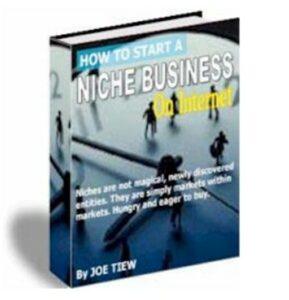How to Start a Niche Business on the Internet
How to Start a Niche Business on the Internet You hear a lot of talk these days about “finding a niche”, as if the concept is new. It’s not.
A niche business is simply a business which serves a highly targeted market group. That’s the short definition.
But there’s something even more important you need to know about niches.
The fact is: a niche is a business idea. Read that again and really think about it. When you zero in on a niche, what you’re really doing is zeroing in on:
1. The audience or target market you would like to serve.
2. The core mission and unique selling proposition of your business.
3. The core product line of your business.
4. The realities of the market guide every aspect of how you structure your business, how you advertise and promote your business, and how you manage the long-range growth of your business.
To find a niche and create a business based on that niche is to stare “marketing reality” in the face. It’s the difference between having a concise business plan and no plan at all.
One maximizes your chances for success, the other is an almost certain road to failure.
So, as you read this and begin to think about niches and niche businesses, keep these points in mind.
Niches are not magical, newly discovered entities. They are simply markets within markets. Hungry and eager to buy.
It’s all “Business Sense 101”.
I created this step-by-step guide to show you the entire process of starting and profiting from an internet-based niche-targeted business. Everything you need to know is here: from researching and surveying your target market, to creating and selling your final product.
You’ll also learn some approaches to what I call “niche thinking”. This is a fancy way of describing the market research process, and how the types of opportunities you spot can vary based on whether you view markets in terms of products first, or people first.
It’s going to be a crash course in rapid business development, so let’s go ahead and get down to the basics of niche research in Step I.
Step I: Understand How Niche Marketers Think and Choose Your Approach
Two Models: Audience-Centric Versus Product-Centric
There are two basic ‘ways of thinking’ about niches. One model takes the audience into consideration first, while the other takes the product into consideration first.
Now, the truth is, both of these models are identical. It’s just that one of them allows you to skip a step. And which one is that? It’s the product-centric model.
So, let’s talk about that one first, and you’ll see what I mean.
Product-Centric
The product-centric model relies on this time-tested rule of marketing: if you want to get into profit quickly, sell what people are already buying!
There’s plenty of data out there about what they sell online. Your job is to identify the gaps in the market and build your niche around them.
For example: books account for a huge portion of online revenue. But how do you grab a slice for yourself without competing against huge companies like Amazon.com?
Answer: You specialize.
As large as Amazon.com is, they still don’t carry everything.
What types of books are people searching for that they can’t find through mainstream booksellers?
Could you become the authority and number one resource for books on a particular hobby?
How about ‘underground’ titles like “The Anarchist’s Cookbook”? That’s what the owners of www.loompanics.com have done. The controversial and “hard to find” titles are all they carry.
Another way you can build a niche around hot-selling products is to give them a twist by customizing or personalizing them. I bet you never thought anyone would want to buy poker chips online, but it turns out that they do when they are custom poker chips.
The game of poker is enjoying resurgence in popularity these days. Along with this renewed interest comes a whole new crop of opportunities to sell books, accessories and gifts to poker fanatics.
Niches within niches abound.
In summary, the product-centric model is based on spinning off existing markets and trends. It is biased towards the sale of tangible items and well-suited to affiliate marketers or to business owners who have the patience and resources needed to deal with inventory, shipping, returns, etc.
Introducing…

Only $7.00
Regards, Coyalita
Copyright © 2022 U.S.A. Ads coyalitalinville.com All Rights Reserved

